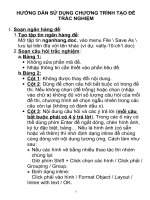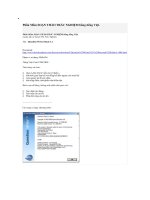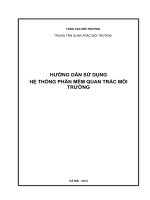Hướng dẫn sử dụng trắc nghiệm TAT
Bạn đang xem bản rút gọn của tài liệu. Xem và tải ngay bản đầy đủ của tài liệu tại đây (1.6 MB, 91 trang )
Thematic Apperception TesT
• is a projective test consisting of a series of
pictures in which the examinee is
requested to create a story about the
picture.
• method of revealing to the trained
interpreter some of the dominant drives,
emotions, sentiments, complexes and
conflicts of personality.
• Apperception – refer to the process of
projecting fantasy imaginary onto an
objective stimuli.
History:
was conceptualized by Henry Murray
and Christina Morgan on 1935.
• Henry Murray
– was born on May 13, 1893 into a wealthy
family.
– Has a good relationship with his father but
poor one with his mother, that result him to
feel depression.
– A turning point in his life occurred at the age
of 30, when he met and fell in love with
Christina Morgan, though married for 7 year.
– Carl Jung advice him not to stop the
relationship with Morgan and keep both
relationships. (1925)
Christina Morgan
- Born in Boston on October 6, 1987
- Had a lot of health problems.
- Drowned herself on March 14, 1967 at the Virgin
Islands
• Morgan – Murray Thematic apperception
Test
– the original name of the TAT but later on
Murray is given primary credit for the test,
along with the staff of Harvard Psychological
Clinic.
• 1938 the year that Tat was established in
Harvard Psychological Clinic
• Explorations in Personality in which the
description of TAT was included.
• Murray’s Theory of Personality
The TAT is so integrally involved with
Murray’s concept of personality that a
survey and knowledge of his basic
theoretical components is important. In
constructing the theory, Murray
emphasizes the biological basis as well as
the social and environmental
determinants of behavior. He is also
consistently aware of how individuals
interact with their environment.
• 1960 – Mrs. Uma Coudhary
developed Indian Adoption of TAT
• Human Potential Movement
– encouraged psychologists to use TAT to
help their clients understand themselves
better and stimulate personal growth.
General Conditions:
• to be administered in an interpersonal
setting.
• TAT materials consists of 20 cards on
which ambiguous pictures are presented.
-”M” for males, “F” for females
-”B” for boys, “G” for girls
-”BM” for boys/males, “GF” for
girls/females.
• The selection of cards may be
idiosyncratic to the patient’s presenting
problem.
SEQUENTIAL NUMBERING SYSTEM (SNS)
a) administered to females and males
in exact order : 1, 2, 3BM, 4, 6BM, 7GF,
8BM, 9GF, 10, 13MF.
b) administered to any males: 1, 2,
3BM, 4, 6BM, 7BM, 11, 12M, 13MF.
c) administered to any females: 1, 2, 3,
3BM, 4, 6GF, 7GF, 9GF, 11, 13GF.
• Research purposes : Keiser and Prather
(1990) specified Murray’s frequent cards.
- 10 most frequent cards : 1, 2, 3BM,
3GF, 4, 5, 6BM, 6GF, 8BM and 8GF.
• During administration, the subject should
be seated beside the examiner with his
or her chair turned away.
Instructions:
• The examiner will show some pictures
one at a time, and the subject will be
making up as dramatic a story as
he/she can for each picture card. 50
minutes for 10 pictures. The following
story structure must be obtained:
a) current situation ; what is
happening at the moment?
b) thoughts and feelings of the
character (s); what the characters are
feeling and thinking?
c) preceding events; what has led up
to the event shown in the picture?
d) outcome ; what was the outcome?
Procedures:
• TIME
time measured should begin when the
picture is first presented and end when the
subject begins his or her story.
• RECORDING
a subject’s complete responses should be
recorded, along with any noteworthy behavioral
observations: exclamation, stuttering, pauses,
blushing, degree of involvement , and
change in voice inflection.
• QUESTIONING and INQUIRY
to produce an unhampered and
free-flow of the subject’s fantasy
material.
• ORDER OF PRESENTATION
usually, the cards should be
administered according to their
sequential numbering system.
• USE OF THE TAT (or CAT) with CHILDREN:
-instructions should be modified in
accordance with their age and
vocabulary.
-for the use with children, the TAT cards
that have the highest number of
interpretable responses and the lowest
number of responses are the following:
a) in order of usefulness : 7GF,
18GF, 3GF, and 8GF.
b) least helpful cards are 19,
18BM, 11 and 12BG
(Bellak and Abrams, 1997)
• CAT usually used to 3-10 yrs old
(Bellak 1949)
• 1965 – CAT-H for 11-15 yrs old
ADDITIONAL INFORMATION:
• TAT to children ages 8-11 yrs old : 1, 3BM,
7GF, 8BM, 12M, 13B, 14, 17BM (Obsrzut
and Boleik 1968)
• TAT for adolescents: 1, 2, 5, 7GF, 12F, 12M,
15, 17BM, 18BM, 18GF
• Children and adolescents of either gender
: 1, 2, 3BM, 4, 5, 6BM, 7GF, 8BM ( Teglasi
1993)
• (Bellak) SENIOR APPERCEPTION TECHNIQUE
(SAT) - for elderly individuals for over 65
years of age.
Scoring:
The Psychological Corporation
For each of the scoring categories,
practitioners should abbreviate their
observations about the person. In some sections,
practitioners are asked to indicate the levels of
importance or strength for the per by putting
one check (mere presence of characteristics),
two checks (moderate) or three checks (strong).
The entire scoring and interpretation procedure
typically takes a half-hour.
• H.A Murray, 1943 scoring the TAT involves
evaluating the following five different aspects
of the stories:
The Hero. Scoring for the hero involves identifying
who is central character(s) in the story
Need of the Hero. For Murray, it was also critical to
identify the needs, motives and desire of the hero.
Identifying the presses. A press refer to any
important environmental factor that may influence
or interfere with the need of the hero.
Example: (parents or boss), (the lock on the door is
broken)
Scoring for themes. Scoring for themes in TAT
stories involves noting the nature of the
interplay and conflict between the needs and
presses, the types of emotion elicited by this
conflict, and the way the conflict is resolved.
Scoring for outcome. Scoring for the outcome
of the story involves analyzing how the stories
end by noting a happy versus unhappy ending
and assessing the extent to which the ending is
controlled by the strengths of the hero and
forces in the environment.
Interpretation:
•
Nomethetic and Idiogrphic.
1. Nomothethic Interpretation refers to the practice
of establishing norms for answer from subjects in
specific age, gender, racial, or educational level
groups and then measuring a given subject’s
responses against those norms.
2. Idiographic Interpretation refers to evaluating the
unique features of the subject’s view of the world
and relationships.
Most psychologists would classify the TAT is
better suited to idiographic than nomothethic
interpretations
• In interpreting the responses of the TAT, the
examiners typically focus their attention on
one of the three (3) areas:
•The content of the stories that the
subject tells;
•The feeling or the tone of the stories;
•The subject’s behavior apart from
responses. These behavior may include:
Verbal Remarks (e.g. comments about
feeling stressed by situation or not being
good story teller) as well as Nonverbal
Actions or Signs (e.g. blushing stammering,
fidgeting in the chair, difficulties making an
eye contact with the examiner, etc.)
• The story content usually reveals the
subject’s attitudes, fantasies, wishes,
inner conflicts, and view of the outside
world.
• The story structure typically reflects the
subject’s feelings, assumptions about
the world, and an underlying attitude
of optimism or pessimism.
• The 3 Levels of Interpretations suggest
by Bellak & Abram, 1997 are:
•Descriptive Level- it is the mere
repeat of the story
•Interpretative Level- It extends the
descriptive level by an alteration of it
[if one does the X, then the outcome
will be Y.].
•Diagnostic Level- It is the further
extension I that an interference is
made about the client.









